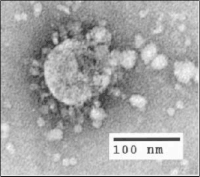
Photo from wikipedia
The COVID-19 epidemic started in Libya in March 2020 and rapidly spread. To shed some light on the severe acute respiratory syndrome coronavirus-2 (SARS-CoV-2) strains circulating in Libya, viruses isolated… Click to show full abstract
The COVID-19 epidemic started in Libya in March 2020 and rapidly spread. To shed some light on the severe acute respiratory syndrome coronavirus-2 (SARS-CoV-2) strains circulating in Libya, viruses isolated from 10 patients in this country were sequenced, characterized at the genomic level, and compared to genomes isolated in other parts of the world. As nine genomes out of 10 belonged to the SS1 cluster and one to SS4, three datasets were built. One included only African strains and the other two contained internationally representative SS1 and SS4 genomes. Genomic analysis showed that the Libyan strains have some peculiar features in addition to those reported in other world regions. Considering the countries in which the strains are genetically more similar to the Libyan strains, SARS-CoV-2 could have entered Libya from a North African country (possibly Egypt), sub-Saharan Africa (e.g., Ghana, Mali, Nigeria), the Middle East (e.g., Saudi Arabia), or Asia (India, Bangladesh).
Journal Title: Microbiological Research
Year Published: 2021
Link to full text (if available)
Share on Social Media: Sign Up to like & get
recommendations!